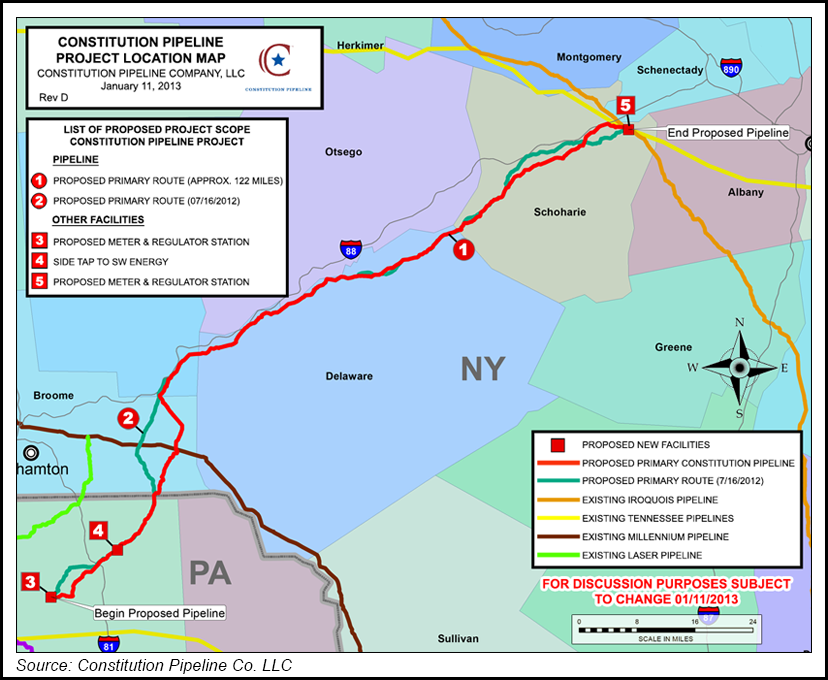Marcellus | E&P | NGI All News Access
Draft EIS Issued for Marcellus Pipeline Projects
A pair of pipeline projects designed to carry natural gas from the Marcellus Shale to markets in the Northeast would have adverse environmental impacts that could be mitigated, FERC said Wednesday.

The Federal Energy Regulatory Commission issued a draft environmental impact statement (EIS) for the Constitution Pipeline Project and the Wright Interconnect Project (Nos. CP13-499-000 and CP13-502-000). The projects were proposed by Constitution Pipeline Co. LLC and Iroquois Gas Transmission, respectively.
The proposed Constitution Pipeline would a 124.4-mile, 30-inch diameter gas line originating in Susquehanna County, PA, and terminating in Schoharie County, NY, where it would interconnect with the Iroquois and Tennessee Gas Pipeline (TGP) systems (see Shale Daily, June 17, 2013). Constitution also includes two new metering and regulating (M&R) stations, two tie-ins and 11 mainline valves. A pig launcher and a pig receiver would be installed at the M&R stations.
Meanwhile, Iroquois has proposed building and operating compressor facilities adjacent to its existing Wright compressor station. Both projects would deliver up to 650,000 Dth/d to the Iroquois and TGP systems for eventual delivery to markets in New York and New England.
“FERC staff concludes that construction and operation of the projects would result in adverse environmental impacts,” the regulatory agency said. However, the impacts “would be reduced to less-than-significant levels” if appropriate action were taken.
According to FERC, both Constitution and Iroquois could minimize the impacts on natural and cultural resources during their projects’ construction and operation by implementing FERC’s Upland Erosion Control Revegetation and Maintenance Plan, and Wetland and Waterbody Construction and Mitigation Procedures.
FERC also recommended that Constitution implement its Soil Protection and Subsoil Decompaction Mitigation Plan; HDD Contingency Plan; Special Crop Productivity Monitoring Procedures; Unanticipated Cultural and Paleontological Resources and Human Remains Discovery Plan; Seeding, Fertilizing, and Lime Recommendations for Gas Pipeline Right-of-Way Restoration in Farmlands; Unanticipated Discovery of Contamination Plan; Spill Plan for Oil and Hazardous Materials; Blasting Plan; Invasive Species Management Plan; Winter Construction Plan; Organic Farm Protection Plan, and Karst Mitigation Plan.
“Our recommendation [is] that Constitution develop a forest (and migratory bird) impact mitigation plan,” and “submit reports on any issues related to private homeowners insurance, and its efforts to resolve them,” said staff.
FERC also recommended that Iroquois adhere to the Spill Prevention, Containment, and Countermeasure Plan, and its Unanticipated Cultural Resource Discovery Plan.
Public comments on the draft EIS are being taken until April 7.
Constitution and Iroquois simultaneously filed their applications with FERC last year, after the two companies reached an agreement for Iroquois to expand the Wright compressor station, thereby eliminating the need for Constitution to build a compressor station in Schoharie (see Shale Daily, Jan. 22, 2013).
Iroquois and TGP have penned a 15-year capacity lease agreement with Constitution.
Constitution is owned by subsidiaries of Williams Partners LP, Cabot Oil & Gas Corp., Piedmont Natural Gas Co. and WGL Holdings (see Shale Daily, June 3, 2013). Constitution and Iroquois had proposed beginning construction for their projects in 2Q2014 and 3Q2014, respectively, and were planning to enter both projects into service by March 2015.
Cabot, one of the biggest Marcellus operators, has agreed to ship 500,000 Dth/d on the pipeline, while Southwestern Energy Services Co. has signed on for 150,000 Dth/d (see Shale Daily, April 27, 2012). Piedmont, a distribution company that serves more than one million customers in the Carolinas and Tennessee, is investing $180 million, but it would not be a customer (see Shale Daily, Nov. 14, 2012).
© 2024 Natural Gas Intelligence. All rights reserved.
ISSN © 2577-9877 | ISSN © 2158-8023 |
